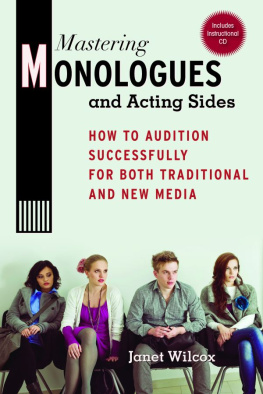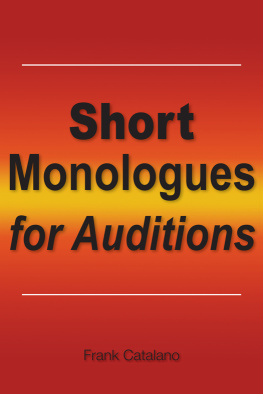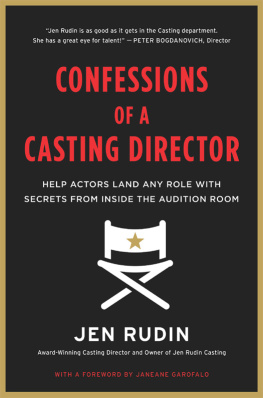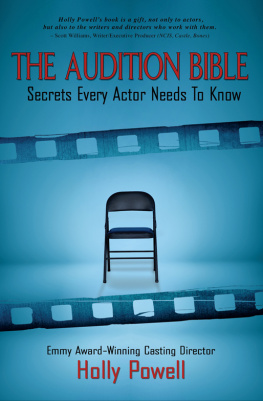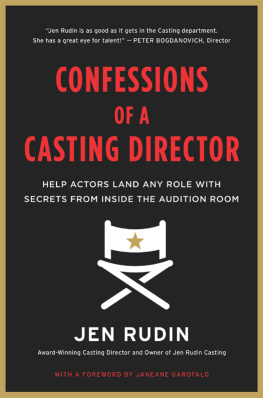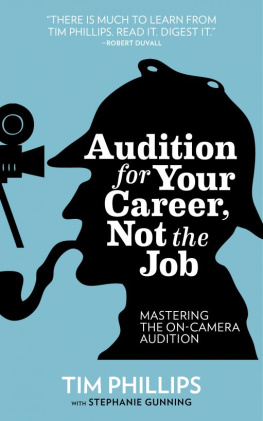
Mastering
M ONOLOGUES
and Acting Sides
HOW TO AUDITION
SUCCESSFULLY
FOR BOTH TRADITIONAL
AND NEW MEDIA
Janet Wilcox

ALLWORTH PRESS
NEW YORK
2011 by Janet Wilcox
All rights reserved. Copyright under Berne Copyright Convention, Universal Copyright Convention, and Pan American Copyright Convention. No part of this book may be reproduced, stored in a retrieval system, or transmitted in any form, or by any means, electronic, mechanical, photocopying, recording or otherwise, without the express written consent of the publisher, except in the case of brief excerpts in critical reviews or articles. All inquiries should be addressed to Allworth Press, 307 West 36th Street, 11th Floor, New York, NY 10018.
Allworth Press books may be purchased in bulk at special discounts for sales promotion, corporate gifts, fund-raising, or educational purposes. Special editions can also be created to specifications. For details, contact the Special Sales Department, Allworth Press, 307 West 36th Street, 11th Floor, New York, NY 10018 or .
15 14 13 12 11 5 4 3 2 1
Published by Allworth Press
An imprint of Skyhorse Publishing
307 West 36th Street, 11th Floor, New York, NY 10018.
Allworth Press is a registered trademark of Skyhorse Publishing, Inc.,
a Delaware corporation.
www.allworth.com
ISBN: 978-1-58115-866-3
Library of Congress Cataloging-in-Publication Data
Wilcox, Janet.
Mastering monologues and acting sides : how to audition successfully
for both traditional and new media / Janet Wilcox.
p. cm.
Includes index.
ISBN 978-1-58115-866-3
1. ActingAuditions. 2. Monologue. I. Title.
PN2071.A92W55 2011
792.02'8dc23
2011022647
Printed in the United States of America
Contents
Appendix
Preface
A t the heart of most Academy Award-winning performances is a great monologue. Tony winners take plays to new heights with a soliloquy at the core of their work, and Emmy winners fill the screen with memorable solo scenes. It is no wonder that novice actors aspire to do a monologue with gusto straight from the gate.
When an actor first decides to take the acting craft seriously, he will begin the climb up monologue mount. Like so many actors, he will struggle to make a solitary performance seem real and dynamic. This element of acting is a rite of passage in class work, and a defining moment in great plays and movies. Classic Academy Award-winning monologues often send chills down your spine. The featured soliloquy is a perfect fit for the performer and often a tour de force of the actors career. For example, Virginia Madsens speech in Sideways was a memorable highlight of her Oscar-nominated performance.
Award-winning performances aside, writers will always take advantage of the powerful impact that soliloquies deliver in a script. Who can forget Ferris Buellers Day Off, a Law & Order murder confession, or a frank soliloquy from The Office? Woody Allen even showcased Larry Davids comedic talents with long monologues in his movie Whatever Works. The truth is, monologues appear in scripts throughout an actors career. They are used in commercials, TV programs, and films. A monologue isnt just for a theater audition; its woven into everything from webisodes to staged testimonials. Its also the litmus test for many actors reaching for a higher level of performance. An inexperienced actor may be asked to perform one by an agent or casting director to demonstrate competence for any number of reasons.
Of course, monologues may be used to showcase skills and to give industry gatekeepers a chance to evaluate an actors talent, but the soliloquy can also help an actor keep fit for any job. Everything a performer does to prepare for a monologue will yield results when he is asked to do a last-minute audition or quickly learn a rewrite on the set. Like scales for a singer, it keeps the actor ready to hit the highs and lows and smooth out the breaks if practiced properly.
PRACTICE MAKES YOU A PRO
This book attempts to encourage actors to embrace a good work ethic to stay in shape between performances and thus to be ready to seize any opportunities that may arise. Scripts are presented for practice and classroom performances. There are also plenty of resources listed to explore additional monologues and audition scenes, including those at your fingertips on the Internet.
These Web references are only suggestions for you to begin your search for material. Sites can always change, so use key words to find new resources. There is no limit to what you can discover, so keep digging. My list is a jumping-off place for you to begin your continuous exploration of what the Web has to offer.
I wrote this book primarily because I realized that the monologue is a benchmark throughout an actors career. First, its an elusive challenge. Then, its a comfortable conversation, and finally, it can be a powerful showpiece for any actor. The search for new material never ends, because an actor evolves, grows, ages, and becomes hungrier to do more challenging parts.
When I began my acting classes, I didnt really like to work on monologues as stand-alone speeches and always preferred doing scenes with other actors. This is ironic because many of my voice-over auditions and bookings are monologues. A voice-over artist performs solo scenes for commercials, narrations, animated characters, audio books, and video games. Therefore, I am constantly trying to imagine that I am in a scene with someone who is not present. This takes a lot of imagination and creativity. In addition, I teach a range of students and witness the many obstacles new and seasoned actors alike consistently face in creating credible performances.
I have also had the opportunity to revisit rudimentary acting classes at UCLA Extension, where I also teach a voice-over class, and I realized that many students begin to work on monologues before first acquiring a strong performing arts foundation. I wanted, therefore, to address the one challenging constant in an actors career: the monologue. I also will compare the soliloquy performance to auditions in which an actor only has an isolated portion of a script, or the sides. These may be used for cold reads if the actor has little preparation time.
The monologue and sides are often removed from a full-length script, and the performer must fill in the missing details. In either case, an actor must rely on his imagination to embellish a partial script and make choices that are appropriate to the role and to the screenwriters vision. These performances require the actor to envision a scene partner and a setting even if a casting director reads the cue lines when sides are used for an audition. Auditioning with sides has a partial interactive element that is missing with a monologue because someone reads the other characters lines, but the quality of the scene partner can be hit or miss. In addition, the common problems of nerves and doubt can derail an audition with sides in the same way that nagging negatives can rob an actor of the ability to perform a monologue well. This book focuses on strategies to help you analyze the type of isolated scenes and monologues that you will have to do for classes, auditions, and jobs.
It is important, however, to note that you must always read a whole script or play if you have it for an audition scene. If you dont, a casting director or teacher will know you didnt do all of your homework. Also, you should be reading full plays and scripts on a regular basis to fully understand how scenes and soliloquies evolve from larger scenarios. The library and Internet are great resources for scripts and plays. By analyzing how scenes and monologues emerge from whole scripts, youll be better prepared to perform auditions, even if you only have a small section of a script.
Next page
